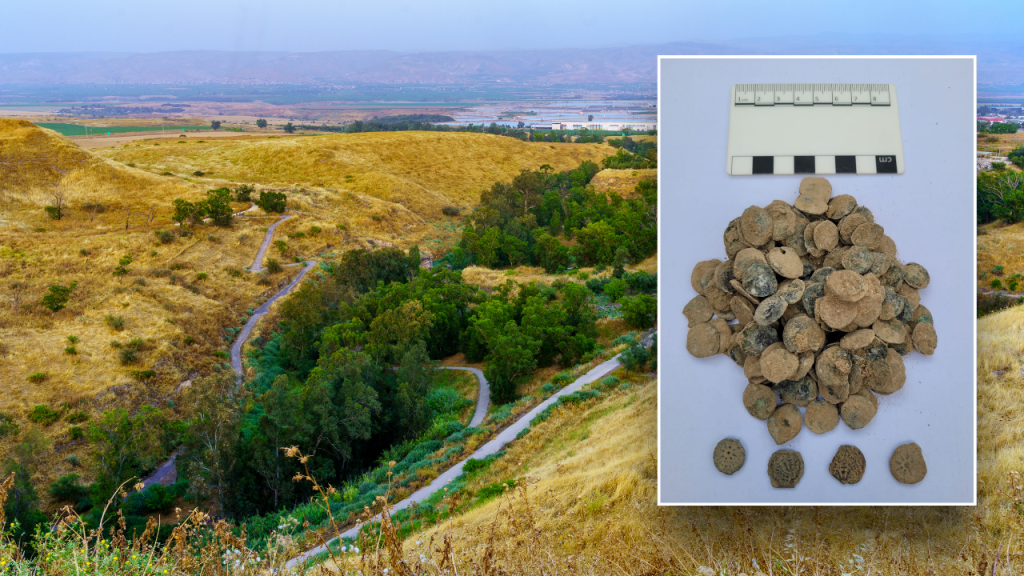A remarkable hoard of 160 ancient coins, dating back to the Hellenistic period, has been unearthed in Israel’s Jordan Valley, offering a tangible link to a pivotal period in Jewish history. Unearthed during Hanukkah, the festival commemorating the rededication of the Second Temple, the discovery carries a poignant resonance, especially given the backdrop of the ongoing Israel-Hamas conflict. The coins, bearing the image of Alexander Jannaeus, a Hasmonean king who ruled Judea from 103 B.C. to 76 B.C., predate the destruction of the Second Temple, a central event in Jewish history and closely intertwined with the Hanukkah narrative. This discovery offers valuable insights into the economic and political landscape of Judea during Jannaeus’s reign, a period marked by both internal strife and expansion of Hasmonean territories.
The sheer size of the coin cache, considered the largest of its kind found in Israel, makes it an exceptional archaeological find. The coins, varying in shape and size, bear inscriptions in both Aramaic and Greek, reflecting the cultural confluence of the era. The presence of these two languages on the coins underlines the Hellenistic influence on Judea while simultaneously showcasing the continued use of Aramaic, the common language of the Jewish people. This bilingual aspect provides valuable context for understanding the cultural dynamics of the region during this historical period. The faint symbols still visible on the coins, despite the passage of centuries, offer a tangible connection to the past, allowing researchers to piece together details of daily life and commerce during the Hasmonean dynasty.
The discovery location itself adds another layer of intrigue to the find. Located at a previously unknown “road station” along the route to Alexandrion, an ancient fortress built by King Jannaeus, the site provides a glimpse into the infrastructure and travel networks of the time. Road stations like this served as vital hubs for travelers, offering respite and provisions along their journeys. The presence of a mikveh, a ritual Jewish bath, at the site suggests that the road station catered to the needs of Jewish travelers, highlighting the importance of religious observance even while on the road. The discovery of a pool or reservoir further emphasizes the site’s role as a vital stopover for replenishing water supplies, a crucial necessity for travelers in the arid Jordan Valley.
The excavation team’s interpretation of the site as a road station aligns with the discovery of the coins within a room likely used as a kitchen. This suggests that the coins may have belonged to someone associated with the operation of the road station, possibly a merchant or administrator. The fact that such a substantial sum of money was found stored in a kitchen further hints at the relative safety and stability of the road station, a place where valuables could be kept securely. This discovery not only sheds light on the economic activities at the road station but also provides valuable information about the daily lives of the people who frequented it.
The timing of the discovery, coinciding with Hanukkah amidst the Israel-Hamas war, added a profound layer of meaning for the archaeologists and student excavators. Dr. Shai Bar, the lead archaeologist, noted the emotional significance of uncovering such a substantial Hasmonean cache during this challenging period. The discovery provided a moment of shared excitement and connection to history, offering a respite from the anxieties of the present conflict. This underscores the power of archaeological discoveries to connect people to their past, providing a sense of continuity and resilience even in times of turmoil. The unearthing of these ancient coins serves as a poignant reminder of the enduring legacy of Jewish history in the region, providing a source of strength and inspiration in the face of contemporary challenges.
This remarkable archaeological find joins a series of recent discoveries in Israel, including a 1,700-year-old oil lamp with soot marks found near the Mount of Olives and a 3,500-year-old Egyptian amulet discovered by a 12-year-old girl. These discoveries highlight the rich tapestry of history woven into the landscape of Israel, constantly revealing new insights into the past. The ongoing archaeological work in the region promises to continue unveiling more such treasures, further enriching our understanding of the diverse cultures and civilizations that have shaped this historically significant land. Each discovery adds another piece to the puzzle, helping to reconstruct the intricate stories of the past and offering a deeper appreciation for the historical depth and complexity of the region.

